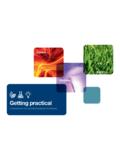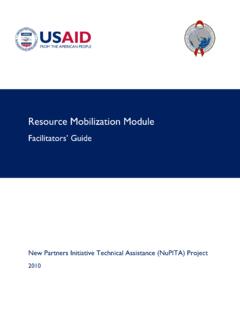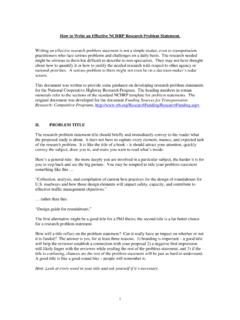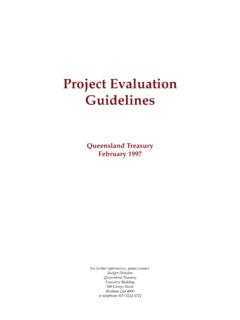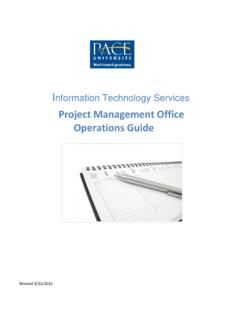Transcription of PRACTICAL WORK IN SCIENCE: A REPORT AND PROPOSAL …
1 PRACTICAL WORK IN SCIENCE: A REPORT AND PROPOSAL FOR A strategic FRAMEWORKThe Science Community Representing Education (SCORE) is a partnership of seven organisations, which aims to improve science education in UK schools and colleges by infl uencing government and policy-makers and supporting the development and implementation of effective education policy and partners share a sense of common purpose and maximise their impact by harnessing the expertise, infl uence and resources of key independent PARTNERS:Association for Science of of Society of EXECUTIVE SUMMARY 1 1 BACKGROUND 4 2 SOURCES OF EVIDENCE 5 Review of research literature 5 Methods 5 Summary of fi ndings from the literature review 5 Surveys by questionnaire of teachers and technicians 7 Evidence submitted by associations and individuals 7 Summary of the evidence base for this REPORT 7 3 CURRENT ISSUES 8 What is meant by PRACTICAL work in science?
2 8 Existing defi nitions of PRACTICAL work 8 Agreed defi nitions of PRACTICAL work 8 Differences between primary and secondary phases 9 Complementary activities 9 Conclusions 9 What are the aims and purposes of PRACTICAL work in science? 10 The purposes of PRACTICAL work in science 10 Differences between primary and secondary phases 10 Conclusions 11 What is the impact of good practice and effective pedagogy?
3 11 From the learner s perspective 12 Teachers confi dence 12 The value of group work 12 Conclusions 12 Enablers and barriers to PRACTICAL work in science 13 Enablers 13 Barriers 14 Resources: equipment and facilities 14 Safety and technical support 15 Curriculum and assessment 15 Time 15 Teacher expertise 16 Training and Professional Development 16 Conclusions 17 Opportunities for the development of PRACTICAL work in science 18 ICT 18 Curriculum and assessment developments
4 18 Conclusions 19 CONTENTSP ractical work in science: a REPORT and PROPOSAL for a strategic framework1 BACKGROUNDThe importance of PRACTICAL work in science is widely accepted and it is acknowledged that good quality PRACTICAL work promotes the engagement and interest of students as well as developing a range of skills, science knowledge and conceptual understanding. It is also acknowledged that in the UK more PRACTICAL work takes place in science lessons than most other countries. However concerns have been expressed by sections of the science community, industry and business that schools in general are not doing enough PRACTICAL work and that its quality is REPORT into PRACTICAL work in science in the UK during 5-19 education reviews evidence and, based on its key fi ndings, proposes a strategic framework for enhancement of the PRACTICAL work in science in schools and OF EVIDENCEB etween September 2007 and June 2008, SCORE engaged with a wide range of stakeholders in order to explore three main questions: What is meant by PRACTICAL work and what is its purpose?
5 What are the factors that facilitate good quality PRACTICAL work and the barriers that militate against it? What are the key elements that need to be addressed in order to improve the quality and the scope of PRACTICAL work in science across schools and colleges?Evidence was drawn from four main sources: a literature review, an open call for evidence, online surveys of teachers and technicians and a series of stakeholder workshops. Throughout, the process for gathering and analysing evidence has been iterative with each stage building on earlier FINDINGS1. There is overarching agreement that PRACTICAL activities can be put into three broad groups: core activities, directly related activities and complementary activities.
6 PRACTICAL work in science includes the core activities and the directly related activities. The complementary activities are important in supporting the development of conceptual understanding in science through PRACTICAL work. PRACTICAL work in science Core activities InvestigationsLaboratory procedures and techniquesFieldwork Directly related activitiesDesigning and planning investigationsData analysis using ICTA nalysing resultsTeacher demonstrationsExperiencing phenomena Complementary activities Science-related visitsSurveysPresentations and role playSimulations including use of ICTM odels and modellingGroup discussionGroup text-based activities2.
7 The importance of PRACTICAL work in science is widely accepted and it is acknowledged that good quality PRACTICAL work promotes the engagement and interest of students as well as developing a range of skills, science knowledge and conceptual There is a strong commitment to high quality PRACTICAL work in science among teachers, technicians, and other stakeholders There is a wide range of good PRACTICAL work in science taking place across the UK but there are indications that the situation could be improved by extending good practice and focussing on the quality, rather than just the quantity, of PRACTICAL work.
8 4 STAKEHOLDER REVIEW OF EVIDENCE 20 Identifi ed issues 20 Defi nitions and purposes 20 Good practice 20 Teachers confi dence and professional development 20 Use and availability of resources 20 Safety and technical support 21 Impact of assessment pressures 21 Recommendations for further work 21 Produce a teacher and technican guide 21 Promote good practice 21 Develop a more coherent, sustained programme of CPD in PRACTICAL work 21 Improve information fl ow about good PRACTICAL science 22 Infl uence policy-makers to take decisions that would support PRACTICAL science 22 Implementing a strategy 22 5 A PROPOSAL FOR A strategic FRAMEWORK 23 Strand A: leadership and management 23 Strand B: communication and dissemination 23 Strand C: ensuring facilities and resources are appropriate 23 Strand D: developing professional expertise in PRACTICAL work in science 23 Strand E.
9 Research and evidence 24 6 CONCLUSIONS 25 REFERENCES 26 APPENDIX 1 QUESTIONNAIRE RESPONDENTS 27 APPENDIX 2 LIST OF INDIVIDUAL RESPONDENTS 28 APPENDIX 3 LIST OF REPRESENTATIVES AT STAKEHOLDER WORKSHOPS 29 ACKNOWLEDGEMENTS 30 EXECUTIVE SUMMARYP ractical work in science: a REPORT and PROPOSAL for a strategic framework3 PRACTICAL work in science: a REPORT and PROPOSAL for a strategic framework25. Effective pedagogy is at the heart of improving the quality of PRACTICAL work in science.
10 When well planned and effectively implemented, PRACTICAL work stimulates and engages students learning at varying levels of inquiry challenging them both mentally and physically in ways that are not possible through other science education Many teachers indicated that they felt confi dent doing PRACTICAL work but there was a very strong indication that this was because they had been able to gain experience over a period of There is well-documented evidence of the shortcomings of equipment funding and replacement of laboratories which require continued monitoring and should be addressed as part of wider strategy and improvement in
